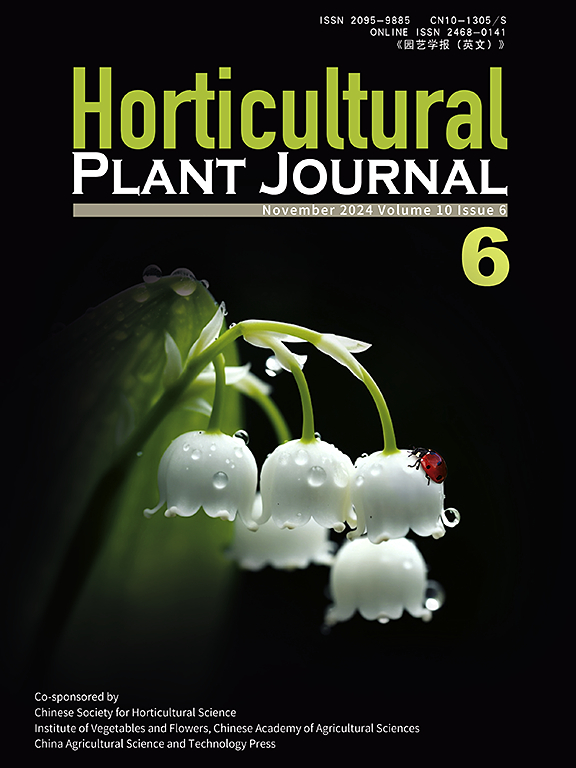柑橘多胚基因CitRWP激活替代性NAD(P)H脱氢酶,触发H2O2积累
IF 6.2
1区 农林科学
Q1 HORTICULTURE
引用次数: 0
摘要
柑橘具有多胚性,这是一种孢子体无融合的形式,涉及到珠心细胞发育成胚胎。最近的遗传定位鉴定出RWP-RK转录因子CitRWP是多胚胎发育的关键调控因子,但在自然界中缺乏纯合子基因型及其启动子。这一现象的机制尚不清楚。本研究表明,CitRWP过表达可诱导拟南芥根系的体细胞胚胎发生,并导致后生Fortunella hindsii营养组织中活性氧(ROS)的积累和细胞死亡。转录组学分析显示,柑橘rwp过表达叶片的ROS代谢、氧化还原调控和抗氧化防御途径中差异表达基因富集。对插入微型反重复转座元件的CitRWP启动子进行分析发现,人工杂交后代中未检测到纯合基因型,表明过表达CitRWP基因型具有致死性。荧光素酶测定、电泳迁移率转移测定和cut - qpcr证实CitRWP直接结合并激活NAD(P)H脱氢酶(NDA)启动子。NDA的过表达导致叶黄素积累、叶片褪绿和生长抑制。我们的研究结果表明,CitRWP通过NDA激活促进H2O2的产生,为其在柑橘多胚发育中的调控作用提供了新的见解。本文章由计算机程序翻译,如有差异,请以英文原文为准。
Citrus polyembryony gene CitRWP activates alternative NAD(P)H dehydrogenase and triggers H2O2 accumulation
Citrus exhibits polyembryony, a form of sporophytic apomixis, which involves development of nucellar cells into embryos. Recent genetic mapping identified CitRWP, an RWP-RK transcription factor as a key regulator of polyembryony, however, there is lack of homozygous genotype of CitRWP and its promoter in nature. The mechanism of this phenomenon remains unclear. Here, we demonstrate that overexpression of CitRWP induces somatic embryogenesis in Arabidopsis roots and leads to the accumulation of reactive oxygen species (ROS) and cell death in vegetative tissues of Fortunella hindsii . Transcriptomic analysis of CitRWP -overexpressing leaves revealed enrichment of differentially expressed genes involved in ROS metabolism, redox regulation, and antioxidant defense pathways. Analysis of the CitRWP promoter with miniature inverted-repeat transposable element (MITE) insertion revealed that no homozygous genotypes were detected among the artificially generated hybrid progeny, which is indicative of lethality of the CitRWP -overexpressing genotype. Luciferase assay, Electrophoretic Mobility Shift Assay, and CUT&Tag-qPCR confirmed that CitRWP directly binds to and activates the alternative NAD(P)H dehydrogenase (NDA ) promoter. Overexpression of NDA in F. hindsii resulted in H2 O2 accumulation, leaf chlorosis, and growth inhibition. Our results indicate that CitRWP promotes H2 O2 production via NDA activation, providing new insights into its regulatory role in citrus polyembryony.
求助全文
通过发布文献求助,成功后即可免费获取论文全文。
去求助
来源期刊

Horticultural Plant Journal
Environmental Science-Ecology
CiteScore
9.60
自引率
14.00%
发文量
293
审稿时长
33 weeks
期刊介绍:
Horticultural Plant Journal (HPJ) is an OPEN ACCESS international journal. HPJ publishes research related to all horticultural plants, including fruits, vegetables, ornamental plants, tea plants, and medicinal plants, etc. The journal covers all aspects of horticultural crop sciences, including germplasm resources, genetics and breeding, tillage and cultivation, physiology and biochemistry, ecology, genomics, biotechnology, plant protection, postharvest processing, etc. Article types include Original research papers, Reviews, and Short communications.
 求助内容:
求助内容: 应助结果提醒方式:
应助结果提醒方式:


